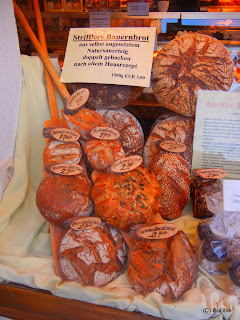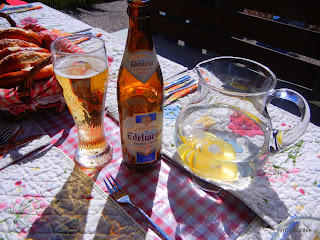(Note: All is well. We were incommunicado in areas without internet access for a few days. Crawling around in castles and palaces and the like.)
The French made a mess of it, as you might expect, but I did my best to put things right again, though it is beyond me why they thought they had to destroy every castle they took on the Rhine River.
 |
| Behind me on the other side of the river is another castle. |
This magnificent fortress, Rheinfels, had been standing since 1245, and you think they would have had a little respect for antiquity. I reckon they just had their armor in a bind because they hadn’t been able to take it forcefully in 1692/93.
But the whole keep and castle was handed over peacefully a century later, so what’s with blowing the castle into rubble?
I mean, look at this place. It was gorgeous, one of the largest fortresses on the river, so why didn’t they just move in their horses and pigs and do a little to maintain the property? It was a perfect location; they could keep an eye on two other castles from its clock tower.
Thank goodness Prince Wilhelm of Prussia bought what was left in 1843 and halted further demolition, but in the meantime, a lot of Rheinfels can be found in another fortress because some oaf was selling off piles of the rubble for other construction.
 |
| One of many narrow passageways. |
Now Rheinfels is owned by the town of St. Goar, which lies at its feet along the Rhine River, on the provision they maintain it, so I spent a couple hours checking on how the townsfolk were holding up their end of the bargain.
Other than letting a hotel open in part of the ruins, they seem to be doing a fine job. While I’m sure some people think staying in a hotel attached to a medieval castle is romantic, somehow it diminishes the historical significance for me, as if this were a theme park.
The little gift shop was nice to have nearby, even though I walked off and left my Rick Steve’s guidebook to Germany on the counter there.
Much of the castle is gone, as I mentioned, mostly the keep where the lord of the castle lived, and the half timber portions. What remains is a warren of earth-floored rooms, tunnels, caves, and towers, more than enough to imagine the smells and noise of the livestock in the inner courtyard, the soldiers manning the various levels of defense, the bakers and brewers and cooks scurrying about in their daily duties.
 |
| I'm going to guess the white part isn't original. All of the timber portions of the castle are gone. |
Clever positioning of revetments allowed cross-fire from many angles, narrow slots for cross-bows, wider slots for pouring nasty substances on an enemy too close to the castle walls, and crenellated parapets on the wall walk for firing on the enemy.
 |
| Pointed revetments allowing for cross-fire. |
I could have spent a couple days there, latching onto a guide who knew the revetments and crenellations intimately, leaching every bit of information he had in his head. With no guide, however, I was left to my own imagination, and it served me well.
 |
| Stairs up to the clock tower. |
 |
| The wine cellar. You could play tennis in here. |
 |
| The larger green area on the left is where the stables were. |
I was lost for hours in these gorgeous remains of a long-ago era. Rheinfels post-dates a smaller toll castle on the river, a toll castle’s purpose being to collect tolls on any vessels passing through that area on the river.
When Count Diether V started constructing a castle on the hill above St. Goar in 1245, expenses got out of hand and he increased the toll. This ticked off the Rhenish Town Alliance and they besieged the castle for a year and 14 weeks, without success.
 |
| The stocks, and a pile of salvaged boulders for the catapult. |
From that time it, a continuing succession of building and defending ensued. Finally, in 1692, the troops of Louis XIV attacked the castle for 14 days before giving up. When the castle was handed over without battle a century later, the French took their revenge on the fortress, blowing much of it to rubble.
I guess they carry grudges a lot time.






















































